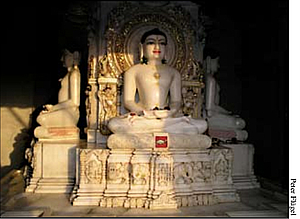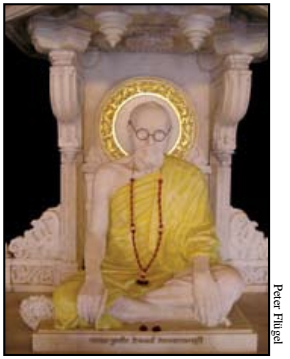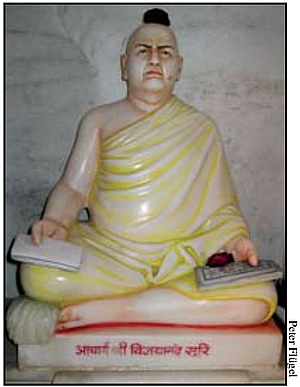
Centre of Jaina Studies Newsletter: SOAS - University of London
Istudied the characteristics of the Mūrtipūjaka
Śvetāmbara Jain lay community in Delhi through the history of the existing 'Old Delhi' Jains and their communities, and the settlements of newcomers since their exodus during the Partition in 1947. The Mūrtipūjaka Jains are a minority in Delhi. There are only 16 Śvetāmbara temples in the Delhi area, but 61 halls (upāśraya) of the Sthānakavāsīs. Historically the Jain community was dominated by the Digambaras (148 temples currently) and confined within the walled-city of Śāhjahānābād in Old Delhi. There have been Mūrtipūjaka communities in Old Delhi for a long time. However, a new Mūrtipūjaka community and temple were established by Panjābī refugees in the newly developed area of North Delhi.
I have conducted fieldwork with the Mūrtipūjaka Śvetāmbara Jain lay community situated in Rūp Nagar, North Delhi. The Rūp Nagar community is unique because of its establishment by Panjābī refugee Jains, and its close relationship with prominent ascetic leaders. The community is affiliated to the Mūrtipūjaka Śvetāmbara Tapā Gaccha, and instructed by a particular organised ascetic group (samudāya).
The socio-religious structure of the Panjābī Śvetāmbara Jains differs from the older communities, Agravāla and Khandelavāla Digambaras and Rājasthānī Śvetāmbaras, in the walled city, which are mostly composed of members of two separate merchant castes. The majority of the Śvetāmbaras are Osvālas, mainly Vīsa Osvālas, and the minority, Khandelavālas. Sthānakavāsīs and followers of the Mūrtipūjaka Kharatara Gaccha are accepted within the community because of their shared history of migration from Rājasthān to Panjāb and Delhi. Over time the Rūp Nagar Mūrtipūjaka Jain community experienced an influx of new migrants from diverse backgrounds, mostly Rājasthānīs and Gujarātīs, joining the community. The present ratio of the community members is 75% Panjābīs and 25% Rājasthānīs and Gujarātīs, according to the President of the Sabhā, Mr. B.C. Jain. The social structure is due to change as a result of the increasing number of non-Panjābī Śrimalīs, besides Osvālas. There are some discrepancies between the Panjābī and other regional members with regard to religious and social interaction. Socio-religious affiliation seems to be quite flexible amongst Panjābī Śvetāmbara Jains. Inter-sectarian marriage of Mūrtipūjakas with Sthānakavāsīs is quite common while it is rare among the Rājasthānīs and Gujarātīs. However, caste endogamy is dominant for all castes, but for a few exceptions, and it is clear that regional origins tend to divide community members.
The history of the Rūp Nagar Mūrtipūjaka community is relatively short. It was created by the Panjābī refugee Jains after their settlement in the middle of the 1950's. They constructed the Śrī Śāntinātha Jain Śvetāmbara Temple in Rūp Nagar in 1961 with donations from the original members of 29 Panjābī refugee families and other Śvetāmbara communities. The Rūp Nagar temple is a concrete symbol of the Panjābī refugee Jains in Delhi. The original Panjābī members of the community are dedicated devotees of the influential Tapā Gaccha Ācāryas Vijaya Ānanda Sūri (1837-1896) and Vijaya Vallabha Sūri (1870-1954), the leaders of a reformed ascetic group in Gujarāt since the mid-19th century and its pupilary lineage of disciples. The Mūrtipūjaka Jains in Panjāb have a specific history in that there was no contact with ascetics for a few centuries until the samvegī (liberation seeking) sādhu reform movement. The local Śvetāmbara tradition was preserved by Mūrtipūjaka yatis (domesticated monks) and the Sthānakavāsī (Dhūndhiyā) ascetics, until the Panjāb Mūrtipūjaka revival was started by two leaders from the samvegī sādhu movement, Muni Būterāy Jī (1807-1882) and Ācārya Vijaya Ānanda Sūri, who were of non-Jain origin, and who had converted from Sthānakavāsī orders to the Tapā Gaccha.

Tirthankara Mallinatha as part of a four-faced (caturmukha) statue at the Vijaya Vallabha Smārak
Before the Partition, in an undivided Panjāb, the Panjābī Mūrtipūjaka Jains were instructed by the charismatic Ācārya Vijaya Vallabha Sūri, who was a disciple of Ācārya Vijaya Ānanda Sūri. As a religious leader Vijaya Vallabha Sūri promoted Jain teachings and ideals, and also campaigned for the development and welfare of the Jain community. He was well known among his followers as a camatkārī, a miracle maker associated with certain divine powers, and also as a social activist among the Jains. Some of my informants in the Rūp Nagar community told me about extraordinary events in which people were protected by the powers of Vijaya Vallabha Sūri. The stories of the exodus from Gujrānvālā, Pakistan together with him and his seven fellow sadhūs and fourteen sādhvīs after paryusana in September 1947 are well known. Hundreds of Jains escaped in trucks sent from India. They travelled in the midst of fierce bombing, and reached the Indian boarder with no damage. All present community members believed this incident was due to the Ācārya's miraculous power.
The members of the Rūp Nagar community, particularly the original Panjābī refugees, are united through continued devotion to Ācārya Vijaya Vallabha Sūri. The elderly members of the community even now express their obligation and gratitude to the Ācārya. There are many devotional songs (bhajana) and prayers dedicated to him, which are sung and recited by the community members and the refugee Jains who went through the ordeal of fleeing from Pakistān with him.
Through the network of relatives and friends the migrants began to settle down in North Delhi, in such places as Kamlā Nagar, Śakti Nagar and Rūp Nagar. Since the refugee Mūrtipūjakas in Delhi from Pakistan and Panjāb recognised one another as followers of Vijaya Vallabha Sūri, most of them came together to form a community. The settled refugee Jains established an association (sabhā), the Śrī Ātmānanda Jain Sabhā in Rūp Nagar, derived from Śrī Ātmānanda Jain Sabhā founded in Zīrā, Panjāb in 1920. The name of the association is dedicated to the prominent Ācārya Vijaya Ānanda Sūri, popularly known as Ātmarāma Jī. Due to their special veneration to Ācārya Vijaya Vallabha Sūri the Sabhā, affiliated to an ascetic order (samudāya) of the Vallabha Samudāya, supports in particular the ascetics from his lineage. The Śrī Ātmānanda Jain Sabhā, Rūp Nagar, functions as the foundation for all migrant Panjābī Jains in terms of administration and religious and social activities in Delhi and the surrounding areas. All Mūrtipūjaka Panjābī Jains register to the Śrī Ātmānanda Jain Sabhā, Delhi (developed from Śrī Ātmānanda Jain Sabhā, Rūp Nagar) as well as their own sabhās in their own residential area. The Delhi Sabhā has come to play the role of the trans- community headquarters for all Delhi Mūrtipūjaka Jains, including the existing Mūrtipūjaka community in Old Delhi. Delhi has become a significant stronghold for the Vallabha Samudāya of the Tapā Gaccha, which is able to extend its influence from Delhi across Northern India.
To commemorate Ācārya Vijaya Vallabha Sūri, the large religious complex called the Śrī Vijaya Vallabha Smārak (Memorial) was constructed in Alipur, on the outskirts of North Delhi. The Vallabha Smārak is the symbol of Vijaya Vallabha Sūri's mission and ideals that were promoted most prominently by his disciple, Sādhvī Mrgāvatī Pūjyā Jī since the 1970's. Mrgāvatī Śrī Jī's veneration towards him resulted in the establishment of the religious complex, comprising Vallabha Surī's Memorial Hall with Śrī Vāspūjya Temple, Padmāvatī Devī Temple, dharmaśālā, bhojanaśālā, and other facilities, such as educational institutions, Jain schools and Indological Institute, at the Smārak. Her strong leadership helped the project to be realised by his devotees, particularly through the great effort of the Panjābī Jains of Rūp Nagar. It is still expanding with lavish donations, not only from the Panjābī devotees but also from those who had connections with Vijaya Vallabha Sūri and his ascetic lineage all over India. The Smārak complex presents a sense of solidarity for the devotees of Vijaya Vallabha Sūri. The cross-community activities of the Smārak are aimed to reproduce the devotion and religious affiliation of the followers of the ascetic orders of Vijaya Ānanda Sūri and Vijaya Vallabha Sūri. The Vallabha Smārak shows the unique interaction between the ascetics and the cross- community members of Vijaya Vallabha Sūri's devotees nationwide.
The religious affiliation to a specific ascetic group is significant for the laity as it relates to the style of ritual.

Statue of Vijaya Vallabha Suri in the Memorial Hall at the Vallabha Smārak.
In the Rūp Nagar community the basic pūjās in the temple, such as the astaprakārī pūjā and the snātra pūjā, are undertaken with reference to the texts scripted by Vijaya Ānanda Sūri, and ceremonial pūjās such as the panca kalyānakapūjā, scripted by Vijaya Vallabha Sūri. Many prayers, composed by Vijaya Vallabha Sūri, are recited by the community members; the ceremonial songs of āratī and mangala dīpaka are sung every evening at the rite, and many prayers are written in poetic language in Hindī. The close relationship with this specific ascetic order is apparent from textual influences through prayers in the rituals conducted by the lay community members. The relationship between this particular local community and its affiliated ascetic order is strengthened by the ritual texts.
In this case of a single local community the relationship between the Rūp Nagar community and the ascetic order of the samudāya is tightly linked, based on the devotion to a specific ācārya since the community's foundation; through patronage; and through its ritual style.
Akiko Shimizu, Researcher at the Eastern Institute, Tokyo, completed her PhD thesis entitled: 'The Religious Life of the Svetāmbara Mūrtipūjaka Jains of the Rūp Nagar Temple Community in North Delhi, India', submitted to the University of London in 2006.

Statue of Ācārya Vijaya Ānanda Sūri at the Vijaya Vallabha Smārak